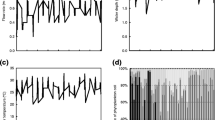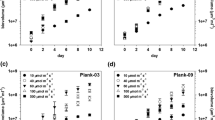Abstract
Massive growth of single species of cyanobacteria is a common phenomenon in many eutrophicated waters worldwide. Allelopathic growth control of phytoplankton species is one suggested mechanism, but still controversially discussed. The fact that the synthesis of biological active compounds requires high energy costs and carbon investment for a single cell in contrast to high dilution rates in natural systems questions the universal validity of allelopathic mechanisms, even more as high concentrations of allelopathic substances are often needed in several experiments to cause biological effects. In this study, it was tested, if growth inhibition is induced by chemical signaling alone or via direct cell–cell interaction. As a test system, we used a co-culture of the green algae Oocystis marsonii (Trebouxiophyceae) with the cyanobacterium Microcystis aeruginosa which is known to strongly reduce the growth of the green algal competitor. In this study, direct co-culturing as well as membrane-separated growth chambers were used to test for chemical and contact-mediated interactions. In the membrane-separated chambers, both species can be co-cultivated and a membrane allows the exchange of metabolites. Growth of O. marsonii was only affected in the direct co-cultivation situation, where direct cell-to-cell contact was possible. During direct co-cultivation, deviating cellular traits, namely cell cycle pattern and large cell-aggregate formation of both species, could be detected. These data strongly support the hypothesis of a direct cell-cell-contact necessary for allelopathic growth control in this model system. Such direct contact would allow targeting allelopathic metabolites directly towards the competitor and thereby minimizing dilution effects.





Similar content being viewed by others
References
Sukenik A, Quesada A, Salmaso N (2015) Global expansion of toxic and non-toxic cyanobacteria: effect on ecosystem functioning. Biodivers Conserv 24:889–908
Legrand C, Rengefors K, Fistarol GO, Granéli E (2003) Allelopathy in phytoplankton—biochemical, ecological and evolutionary aspects. Phycologia 42(4):406–419
Granéli E, Weberg M, Salomon PS (2008) Harmful algal blooms of allelopathic microalgal species: the role of eutrophication. Harmful Algae 8:94–102
Jonsson PR, Pavia H, Toth G (2009) Formation of harmful algal blooms cannot be explained by allelopathic interactions. Proc Natl Acad Sci 106(27):11177–11182
Leao PN, Vasconcelos MTSD, Vasconcelos VM (2009) Allelopathy in freshwater cyanobacteria. CRC Cr Rev Microbiol 35(4):271–282
Kaebernick M, Neilan BA (2001) Ecological and molecular investigations of cyanotoxin production. FEMS Microbiol Ecol 35:1–9
Holland A, Kinnear S (2013) Interpreting the possible ecological role(s) of cyanotoxins: compounds for competitive advantage and/or physiological aide? Marine Drugs 11:2239–2258
Gehringer MM, Wannicke N (2014) Climate change and regulation of hepatotoxin production in cyanobacteria. FEMS Microbiol Ecol 88:1–25
Vézie C, Rapala J, Vaitomaa J, Seitsonen J, Sivonen K (2002) Effect of nitrogen and phosphorus on growth of toxic and nontoxic microcystis strains and on intracellular microcystin concentrations. Microb Ecol 43:443–454
Leflaive J, Ten-Hage L (2007) Algal and cyanobacterial secondary metabolites in freshwaters: a comparison of allelopathic compounds and toxins. Freshw Biol 52:199–214
Smith GD, Doan NT (1999) Cyanobacterial metabolites with bioactivity against photosynthesis in cyanobacteria, algae and higher plants. J Appl Phycol 11:337–344
Singh DP, Tyagi MB, Kumar A, Thakur JK, Kumar A (2001) Antialgal activity of a hepatotoxin-producing cyanobacterium, Microcystis aeruginosa. World J Microb Biotechnol 17:15–22
Babica P, Hilscherová K, Bártova K, Bláha L, Marsálek B (2007) Effects of dissolved microcystins on growth of planktonic photoautotrophs. Phycologia 46(2):137–142
Dunker S, Jakob T, Wilhelm C (2013) Contrasting effects of the cyanobacterium Microcystis aeruginosa on the growth and physiology of two green algae, Oocystis marsonii and Scenedesmus obliquus, revealed by flow cytometry. Freshw Biol 58(8):1573–1587
Paul C, Mausz MA, Pohnert G (2013) A co-culturing/metabolomics approach to investigate chemically mediated interactions of planktonic organisms reveals influence of bacteria on diatom metabolism. Metabolomics 9(2):349–359
Guilliard RRL, Lorenzen CJ (1972) Yellow-green algae with chlorophyllide c. J Phycol 8:10–14
Jeffrey SW, Humphrey GF (1975) New spectroscopic equations for determining chlorophylls a, b, c1, c2 in higher plants, algae and natural phytoplankton. Biochemie Pflanzen 167:191–194
Ziegler E, Egle K (1965) Zur quantitativen Analyse der Chloroplastenpigmente. I. Kritische Überprüfung der spektralphotometrischen Bestimmung. Beiträge Biologie Pflanzen 41:11–37
Oliver RL, Kinnear AJ, Ganf GC (1981) Measurement of cell density of three freshwater phytoplankters by density gradient centrifugation. Limnol Oceanogr 26(2):285–294
Barco M, Rivera J, Caixach J (2002) Analysis of cyanobacterial hepatotoxins in water samples by microbore reversed-phase liquid chromatography-electrospray ionization mass spectrometry. J Chromatogr A 959(1–2):103–111
Lawrence JF, Niedzwiadek B, Menard C, Lau BPY, Lewis D, Kuper-Goodman T (2001) Comparison of liquid chromatography/mass spectrometry, ELISA, and phophatase assay for the determination of microcystins in blue-green algae products. J AOAC Int 84(4):103–111
Yamamoto M, Fujishita M, Hirata A, Kawano S (2004) Regeneration and maturation of daughter cell walls in the autospore-forming green alga Chlorella vulgaris (Chlorophyta, Trebouxiophyceae). J Plant Res 117:257–264
Loos E, Meindl D (1985) Cell-wall-bound lytic activity in Chlorella fusca: function and characterization of an endo-mannanase. Planta 166:557–562
Kwok ACM, Wong JTY (2003) Cellulose synthesis is coupled to cell cycle progression at G1 in the dinoflagellate Crypthecodinium cohnii. Plant Physiol 131:1681–1691
Kromkamp J (1987) Formation and functional significance of storage products in cyanobacteria. N Z J Mar Freshw Res 21(3):457–465
Wagner H, Dunker S, Liu Z, Wilhelm C (2013) Subcommunity FTIR-spectroscopy to determine physiological cell states. Curr Opin Biotech 24:88–94
Tillman U (2003) Kill and eat your predator: a winning strategy of the planktonic flagellate Prymnesium parvum. Aquat Microb Ecol 32:73–84
Orr PT, Jones GJ (1998) Relationship between microcystin production and cell division rates in nitrogen-limited Microcystis aeruginosa cultures. Limnol Oceanogr 43(7):1604–1614
Wiedner C, Visser PM, Fastner J, Metcalf JS, Codd GA, Mur LR (2003) Effects of light on the microcystin content of microcystis strain PCC 7806. Appl Environ Microbiol 69(3):1475–1481
Sivonen K, Jones G (1999) Cyanobacterial toxins. In: Chorus I, Bartram J (eds) Toxic cyanobacteria in water: A guide to their public health consequences, monitoring and management. WHO St Edmundsbury Press, London, pp 55–124
Bagchi SN, Palod A, Chauhan VS (1990) Algicidal properties of a bloom-forming blue-green alga, Oscillatoria sp. J Basic Microbiol 30(1):21–29
Uchida T, Toda S, Matsuyama Y, Yamaguchi M, Kotani Y, Honjo T (1999) Interactions between the red tide dinoflagellates Heterocapsa circularisquama and Gymnodinium mikimotoi in laboratory culture. J Exp Mar Biol Ecol 241:285–299
Uchida T (2001) The role of cell contact in the life cycle of some dinoflagellate species. J Plankton Res 23(8):889–891
Acknowledgements
Thanks goes to David Förster for performing the growth assays with culture supernatants during his bachelor thesis. We also thank all four reviewers for their constructive improvement of the manuscript.
Author information
Authors and Affiliations
Corresponding author
Additional information
Highlights
- Growth and cellular development of the green algae O. marsonii was only impaired in direct mixture with M. aeruginosa and not in membrane-separated chambers of both species.
- Effects on cell cycle of O. marsonii and detection of cell-cell aggregates of both species in direct mixed culture suggest that growth control is based on cell-cell-contacts in this study.
- Excretion of allelopathic compounds means high dilution rates for allelopathic substances in contrast to high metabolic costs for the producing organism.
- This cell–cell contact would be a valuable explanation for the application of a targeted and effective dose of allelopathic substances, without dilution effects.
Rights and permissions
About this article
Cite this article
Dunker, S., Althammer, J., Pohnert, G. et al. A Fateful Meeting of Two Phytoplankton Species—Chemical vs. Cell-Cell-Interactions in Co-Cultures of the Green Algae Oocystis marsonii and the Cyanobacterium Microcystis aeruginosa . Microb Ecol 74, 22–32 (2017). https://doi.org/10.1007/s00248-016-0927-1
Received:
Accepted:
Published:
Issue Date:
DOI: https://doi.org/10.1007/s00248-016-0927-1




